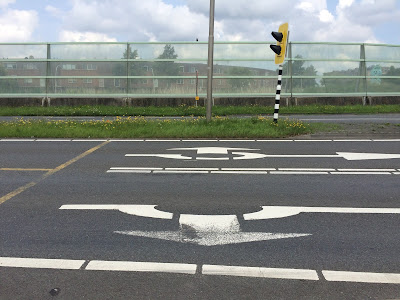It's not every day you get a full-fledged explanation of the genius behind the roundabout traffic concept by the very inventor of the turbo roundabout. The turbo roundabout is a multi-lane traffic design that creates order out of complex intersections. Although the civil engineering science behind the scenes was a bit over my head, one lesson I've learned for any future planning projects in neighborhood traffic sustainability and safety is that roundabouts enhance traffic safety, efficiency, and mobility for drivers and cyclists alike.
According to statistics and simulation models shown to us, roundabouts hold sufficient capacity for the smooth flow of traffic, while preventing accidents, particularly T-bones which typically result in the worst damage. Most importantly, they slow speeds to protects cyclists, pedestrians, and drivers. After all, speed is a significant indicator of the severity of an accident.
Roundabouts can be optimized with the proper design features in order to avoid side crashes and overcapacity, including road dimensions and turning widths, redundant signage overhead and on the road itself, raised blocks, bollards, or other physical barriers to separate lanes, a raised center surface, and traffic signals about 30 meters from the entrance of the traffic circle to regulate traffic. With multiple lanes and entrances, complexity is increased, and other dividing lines and regulating measures must be put in place. Strangely enough, increasing roundabout complexity with good design can make drivers more aware and cautious about using them, and therefore, increase safety. In addition, tunnels and two-way cycling tracks on one side can be used to ensure cyclists' visibility, and thus safety, to drivers. Additional research has been done showing that when cyclists have to yield to drivers on entering and exiting roundabouts, accident frequency is reduced by about a half.
Lessons learned? Roundabouts are an essential component of sustainable and safe communities. Some unanswered questions of mine include whether roundabouts might help solve some of the more severe traffic problems in urban megapolises, particularly in the Global South, such as Jakarta, Manila, Hanoi, Sao Paolo, and Mumbai, which suffer from too many cars on the road and often have their own intuitive methods of organizing and moving traffic.
According to statistics and simulation models shown to us, roundabouts hold sufficient capacity for the smooth flow of traffic, while preventing accidents, particularly T-bones which typically result in the worst damage. Most importantly, they slow speeds to protects cyclists, pedestrians, and drivers. After all, speed is a significant indicator of the severity of an accident.
Roundabouts can be optimized with the proper design features in order to avoid side crashes and overcapacity, including road dimensions and turning widths, redundant signage overhead and on the road itself, raised blocks, bollards, or other physical barriers to separate lanes, a raised center surface, and traffic signals about 30 meters from the entrance of the traffic circle to regulate traffic. With multiple lanes and entrances, complexity is increased, and other dividing lines and regulating measures must be put in place. Strangely enough, increasing roundabout complexity with good design can make drivers more aware and cautious about using them, and therefore, increase safety. In addition, tunnels and two-way cycling tracks on one side can be used to ensure cyclists' visibility, and thus safety, to drivers. Additional research has been done showing that when cyclists have to yield to drivers on entering and exiting roundabouts, accident frequency is reduced by about a half.
Lessons learned? Roundabouts are an essential component of sustainable and safe communities. Some unanswered questions of mine include whether roundabouts might help solve some of the more severe traffic problems in urban megapolises, particularly in the Global South, such as Jakarta, Manila, Hanoi, Sao Paolo, and Mumbai, which suffer from too many cars on the road and often have their own intuitive methods of organizing and moving traffic.
 |
| Metering is used to communicate to drivers when it is safe to enter a roundabout, while regulating the flow of traffic |
 |
| Redundant and bold signage helps prevent lane switching once in the roundabout |
No comments:
Post a Comment